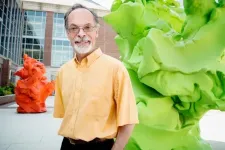Now a new study in Nature led by a team from the University of Pennsylvania has revealed how two different variations--one that increases disease risk and leads to more severe disease in people who develop Parkinson's and another that reduces risk--manifest in the body.
The work, led by Dejian Ren, a professor in the School of Arts & Sciences' Department of Biology, showed that the variation that raises disease risk, which about 17% of people possess, causes a reduction in function of an ion channel in cellular organelles called lysosomes, also known as cells' waste removal and recycling centers. Meanwhile, a different variation that reduces Parkinson's disease risk by about 20% and is present in 7% of the general population enhances the activity of the same ion channel.
"We started with the basic biology, wanting to understand how these lysosomal channels are controlled," says Ren. "But here we found this clear connection with Parkinson's disease. To see that you can have a variation in an ion channel gene that can change the odds of developing Parkinson's both ways--increasing and decreasing it--is highly novel."
The fact that the channel seems to play a crucial role in Parkinson's also makes it an appealing potential target for a drug that could slow the disease's progression, the researchers note.
Scientists have understood since the 1930s that cells use carefully regulated ion channels embedded in their plasma membrane to control crucial aspects of their physiology, such as shuttling electrical impulses between neurons and from neurons to muscles.
But it wasn't until the past decade that researchers began to appreciate that the organelles within cells that have membranes, including endosomes and lysosome, also relied on ion channels to communicate.
"One reason is it's hard to look at them because organelles are really small," Ren says. During the last several years, his lab overcame this technical challenge and began studying these membrane channels and measuring the current of ions that crosses through them.
These ions pass through channel proteins that open and close in response to specific factors. About five years ago, Ren's group identified one membrane protein, TMEM175, that forms a channel allowing potassium ions to move in and out.
Around the same time, other teams doing genome-wide association studies found two variations in TMEM175 that influenced Parkinson's disease risk, turning it up or down.
"One variation is associated with a 20-25% increase in the odds of getting Parkinson's in the general population," Ren says. "And if you look only at people who have been diagnosed with Parkinson's, the frequency of that variation is even higher."
Intrigued by the connection, Ren reached out to Penn physician-scientist Alice Chen-Plotkin, who works with patients who have Parkinson's, to collaborate. In data from Parkinson's disease patients, she and colleagues found that motor and cognitive impairments progressed more rapidly in those patients who carried one of the TMEM175 genetic variations Ren was studying.
To find out what this variation was actually doing in cells, Ren's lab turned a close eye to lysosomes. In isolation, they found that the potassium current through TMEM175 was activated by growth factors, proteins like insulin that respond to the presence of nutrients in the body. And they confirmed that TMEM175 appeared to be the only active potassium channel in mouse lysosomes.
"When you starve a cell, this protein is not functional anymore," Ren says. "That was exciting to us because that tells us this is a major mechanism that can be used by the organelle to receive communications from the outside of the cell and maybe send communication back out."
They found that a kinase enzyme called AKT, which is typically thought to achieve its ends by adding a small molecule called a phosphate group to whatever protein it is acting upon, joined with TMEM175 to open the protein channel. But AKT opened it without introducing a phosphate group. "The textbook definitation of a kinase is that it phosphorylates proteins," Ren says. "To find this kinase acting without doing that was very surprising."
They next turned to mice genetically engineered to carry the same variations that had been found in the human population to see how the genetic changes affected the animals' ion channel activity. Mice with the disease-risk-increasing mutation had a potassium current of just about 50% of that of normal mice, and that current was extinguished in the absence of growth factors. In contrast, the ion channels in mice with the disease-risk-reducing mutation continued operating for several hours in the absence of growth factors, even longer than they did in normal mice.
"This tells you this mutation is somehow helping the mice resist the effects of nutrient depletion," Ren says.
To measure effects on neurons, they observed that the neurons with the mutation in cell culture associated with more severe Parkinson's were more susceptible to damage from toxins and nutrient depletion. "If the same is true in human neurons, that means 17% of the population carries a variation that may make their neurons more damaged when subjected to stressors," says Ren.
Collaborating with Penn researcher Kelvin Luk, the investigators looked at levels of misfolded protein in neurons in cell culture. Known in humans as Lewy bodies and a defining characteristic of Parkinson's, these inclusions increased "strikingly" within neurons when TMEM175 function declined, Ren says. This is likely due to an impairment in the function of lysosomes, which normally help digeset and recycle waste generated by the cell.
And, also associated with human Parkinson's, mice lacking TMEM175 lost a portion of the neurons that produce the neurotransmitter dopamine and performed worse on tests of coordination than normal mice.
Together with the findings in humans, the researchers believe their work points to a significant contributor to the pathology of Parkinson's disease. Moving forward, Ren's group hopes to delve deeper into the mechanism through which this ion channel is regulated. Their research may shed light not only on the molecular impairments involved in Parkinson's but also in other neurodegenerative diseases, particular those related to lysosomes, which include a number of rare but very severe conditions.
They'd also like to know, since this predisposing variation is carried by so many people, if it also influences how other genetic mutations contribute to the likelihood someone develops Parkinson's.
INFORMATION:
Dejian Ren is a professor of biology in the University of Pennsylvania School of Arts & Sciences.
Ren's coauthors are Jinhong Wie, Zhenjiang Liu, Chunlei Cang, Kimberly Aranda, and Joey Lohmann of Penn's School of Arts & Sciences; Thomas F. Tropea, Yuling Liang, Alice S. Chen-Plotkin, and Kelvin C. Luk of Penn's Perelman School of Medicine; Haikun Song and Boxun Lu of China's Fudan University; and Lu Yang, Huanhuan Wang, and Jing Yang of China's Peking University. Jinhong Wie is first author and Ren, Chen-Plotkin, and Luk are corresponding authors.
The work was supported in part by the National Institutes of Health (grants GM133172, HL147379, NS088322, NS115139, NS053488, and AG062418).


